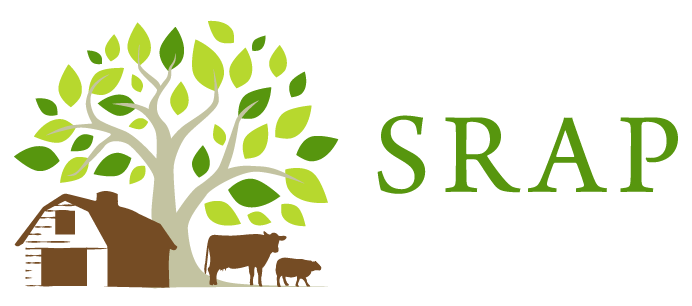Share
Overview
SRAP created this map to show the connection between industrial livestock production and water pollution in the U.S. The map depicts livestock density by county, calculated using data from USDA’s 2017 Census of Agriculture, along with polluted waterways reported in U.S. EPA’s 303(d) list of impaired waters.
Background
In the U.S., most meat, dairy products, and eggs are produced by industrial livestock facilities that confine thousands—or even millions—of animals without access to pasture. These operations are known to pose serious threats to the environment, public health, and socioeconomic conditions in surrounding communities, primarily due to pollution caused by the vast quantity of animal waste they generate.
As a result of waste spills, faulty storage, overapplication of waste to land, and other forms of waste mismanagement, industrial livestock operations cause significant water pollution, contaminating ground and surface waters with nitrogen, phosphorus, heavy metals, pathogens like E. coli and Salmonella, and other pollutants.
In response to the national water pollution crisis, U.S. EPA maintains the 303(d) list of impaired waters depicted in this map. While industrial livestock operations aren’t the only polluters, this map enables users to observe the correlation between extreme concentration of livestock and high rates of water impairment across the U.S.
Map Methodology
SRAP developed this map using publically available data from several government sources. The impaired waters layers were produced by U.S. EPA and state regulatory agencies in Michigan and Minnesota, and SRAP produced the Livestock Density layer based on the methodology described below.
Livestock Density (Animal Units)
SRAP created this layer using data from the 2017 Census of Agriculture published by the U.S. Department of Agriculture (USDA) National Agricultural Statistics Service (NASS). Conducted every five years, the Census of Agriculture is a complete count of U.S. farms and ranches, providing comprehensive data on land use, production practices, operator characteristics, and a wide range of other agricultural information. (As of publication of this map in September 2023, the 2017 Census of Agriculture was the most recent census published by USDA.)
We produced the Livestock Density layer by converting the total number of beef cattle, dairy cattle, swine, calves, broiler chickens, and layer chickens into animal units, and calculating animal unit totals for each U.S. county. We obtained animal number totals from the livestock – total heads [sic] (by county) GIS layers created by Enviroatlas using 2017 Census of Agriculture data. We calculated animal unit totals by multiplying total animal numbers by the conversion factors below, which regulatory agencies have developed to convert animals of different species or sizes into an equivalent unit.
Animal unit conversion factors for species included in the Livestock Density layer:
- Total Beef Cattle x 1.00 (U.S. EPA)
- Total Dairy Cattle x 1.40 (U.S. EPA)
- Total Swine x 0.40 (U.S. EPA)
- Total Calves x 0.20 (Wisconsin DNR)
- Total Broiler Chickens x 0.10 (Iowa DNR)
- Total Layer Chickens x 0.10 (Iowa DNR)
Conversion factor sources:
U.S. EPA, “Manual on NPDES Regulations for Concentrated Animal Feeding Operations”
Wisconsin DNR, “Animal Unit Calculation Worksheet”
Iowa DNR, “Animals to Animal Units Conversion”
We configured six classifications in the Livestock Density map layer and normalized this data using a per square mile process in order to adjust raw counts into relative data.
Impaired Waters
U.S. EPA CWA 303(d) Impaired Waters (U.S. EPA)
This layer shows the polluted waterways included in U.S. EPA’s 303(d) list of impaired waters. Under section 303(d) of the Clean Water Act (CWA), states, territories, and authorized tribes are required to identify impaired waters (i.e., streams, rivers, lakes, and other water bodies that fail to meet state water quality standards), and share them with U.S. EPA in a 303(d) list. States are also required to establish priority rankings for these waters, and to develop total maximum daily loads (TMDLs) to protect them. A TMDL is the maximum amount of a pollutant that can enter a water body so that the water body is still able to meet water quality standards for that pollutant.
Sources:
EPA 303(d) listed impaired waters overview
Impaired Great Lakes/Bays MI 2020 (MI EGLE)
This layer includes impaired waters in the Great Lakes/Bays region of Michigan. We added this layer to the map to supplement the impaired waters data included in U.S. EPA’s 303(d) list. The layer is a subset of Michigan’s hydrologic features described in the biennial publication on the quality of Michigan’s water resources.
Sources:
Michigan Department of Environment, Great Lakes and Energy (MI EGLE) 2020 Integrated Report
Impaired Lakes MN 2022 (MN DNR)
This layer includes additional impaired waters datasets in the Great Lakes area. We added this layer to the map to supplement impaired waters data included in U.S. EPA’s 303(d) list. These lakes are a subset of the National Hydrography Dataset (NHD). In cases where the NHD did not include lakes that MPCA has assessed, we added lakes from the MN Department of Natural Resources (DNR) Division of Waters lakes database. This dataset includes impaired lakes that have not yet had a TMDL plan approved by the U.S. EPA, those that have a U.S. EPA -approved TMDL plan, as well as those lakes that do not need a TMDL plan.
Sources:
